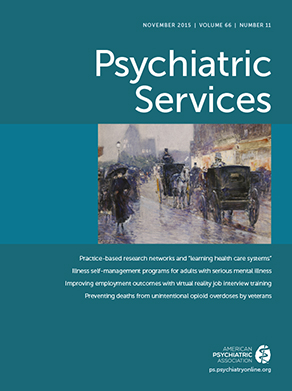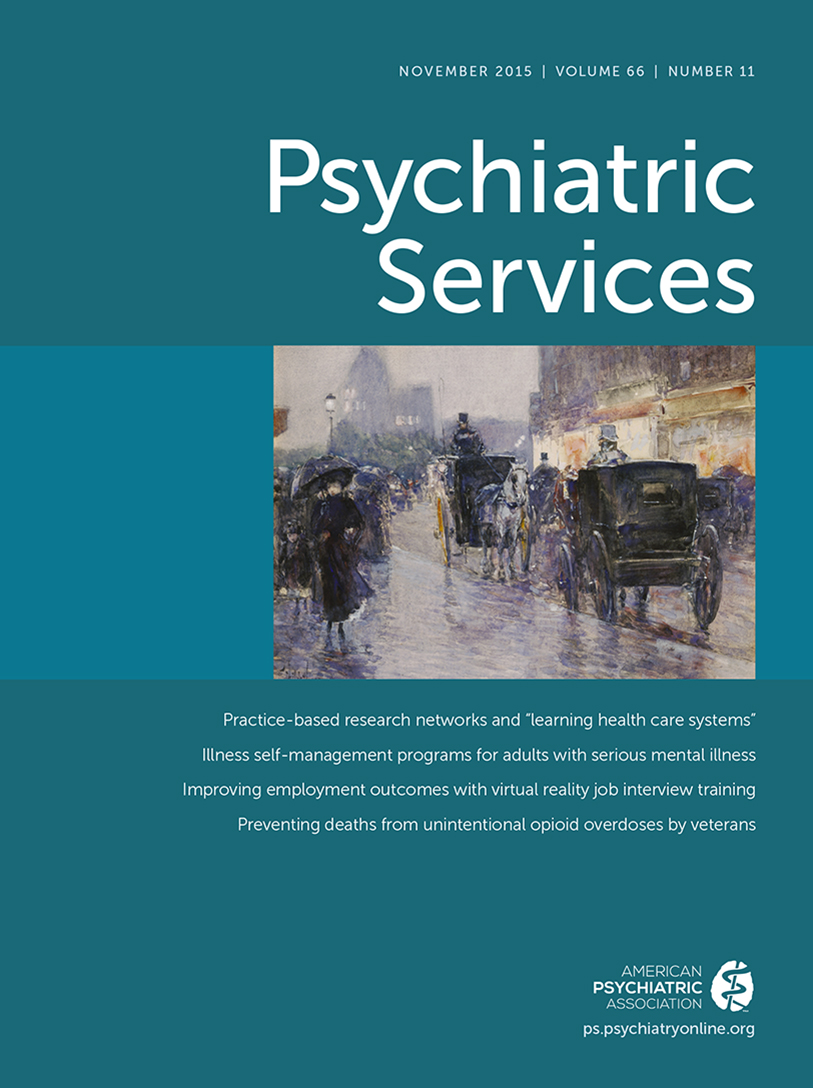Effect of Pediatric Behavioral Health Screening and Colocated Services on Ambulatory and Inpatient Utilization
Abstract
Objective:
Methods:
Results:
Conclusions:
Methods
Conceptual Framework
Context
Screening and Colocation Model
Study Population
Variables
ITS Analysis
Results
| Characteristic | Pediatric primary care patients (N=11,223, for 3 sites) | |||
|---|---|---|---|---|
| Prepolicy (N=8,235) | Postpolicy (N=9,552) | |||
| N | % | N | % | |
| Sex | ||||
| Female | 4,032 | 49.0 | 4,641 | 48.6 |
| Male | 4,203 | 51.0 | 4,911 | 51.4 |
| Language | ||||
| English | 6,475 | 78.6 | 7,392 | 77.4 |
| Portuguese | 758 | 9.2 | 1,069 | 11.2 |
| Spanish | 342 | 4.2 | 487 | 5.1 |
| Haitian | 177 | 2.2 | 254 | 2.7 |
| Other | 409 | 5.0 | 323 | 3.4 |
| Unknown | 74 | .9 | 27 | .3 |
| Race-ethnicity | ||||
| White, non-Hispanic | 3,795 | 46.1 | 4,175 | 43.7 |
| Black, non-Hispanic | 1,734 | 21.1 | 2,075 | 21.7 |
| Hispanic | 1,014 | 12.3 | 1,257 | 13.2 |
| Asian | 384 | 4.7 | 537 | 5.6 |
| Other, non-Hispanic | 1,095 | 13.3 | 1,315 | 13.8 |
| Unknown | 213 | 2.6 | 193 | 2.0 |
| Age (years) at start of periodb | ||||
| <4.8 | 603 | 7.3 | 1,243 | 13.0 |
| 4.8–6.9 | 1,219 | 14.8 | 1,330 | 13.9 |
| 7.0–9.9 | 1,756 | 21.3 | 1,771 | 18.5 |
| 10.0–12.9 | 1,794 | 21.8 | 1,862 | 19.5 |
| 13.0–15.9 | 1,717 | 20.9 | 2,083 | 21.8 |
| 16.0–18.0 | 1,008 | 12.2 | 1,080 | 11.3 |
| >18.0 | 138 | 1.7 | 183 | 1.9 |
| Insurance, at policy implementationc | ||||
| Medicaid | 2,451 | 29.8 | 3,587 | 37.6 |
| Free care or public | 1,218 | 14.8 | 1,736 | 18.2 |
| Private | 3,035 | 36.9 | 3,579 | 37.5 |
| Other | 41 | .5 | 50 | .5 |
| Not indicated | 1,490 | 18.1 | 600 | 6.3 |
| First behavioral diagnosis at specialty behavioral visitsd | ||||
| Episodic mood disorder (bipolar) | 849 | 25.12 | 1249 | 20.6 |
| Hyperkinetic syndrome | 833 | 24.6 | 1471 | 24.1 |
| Adjustment reaction | 631 | 18.7 | 1691 | 27.7 |
| Anxiety, dissociative, or somatoform disorder | 579 | 17.1 | 782 | 12.8 |



| Variable | Estimate (visits per 1,000 patients) | SE | 95% CI | p |
|---|---|---|---|---|
| Specialty behavioral health servicesa | ||||
| Intercept | 14.99 | .51 | 13.96 to 16.02 | <.001 |
| Trend change | .13 | .06 | .00 to .25 | .049 |
| Trend | .07 | .04 | –.01 to .16 | .099 |
| Behavioral health–related primary care visitsb | ||||
| Intercept | 8.48 | .32 | 7.84 to 9.12 | <.001 |
| Trend change | .19 | .02 | .15 to .23 | <.001 |
| Behavioral health–related emergency department visitsc | ||||
| Intercept | 1.42 | .26 | .89 to 1.95 | <.001 |
| Trend change | .10 | .03 | .04 to .16 | .002 |
| Trend | –.03 | .02 | –.08 to .01 | .144 |
| Behavioral health–related inpatient hospitalizationsd | ||||
| Intercept | .32 | .12 | .08 to .57 | .012 |
| Level change | –.47 | .32 | –1.12 to .18 | .154 |
| Trend change | .04 | .02 | .01 to .07 | .019 |
| Behavioral health–related inpatient hospitalizations or emergency department visitsc,d | ||||
| Intercept | 1.47 | .29 | .88 to 2.05 | <.001 |
| Trend change | .11 | .03 | .04 to .18 | .003 |
| Trend | −.03 | .02 | –.08 to .01 | .157 |
| Any behavioral health–related utilizationa–d | ||||
| Intercept | 23.93 | .32 | 23.29 to 24.57 | <.001 |
| Level change | 1.50 | .90 | –.30 to 3.31 | .102 |
| Trend change | .36 | .04 | .28 to .45 | <.001 |
| Non–behavioral health–related utilizatione | ||||
| Intercept | 83.70 | 1.00 | 81.68 to 85.71 | <.001 |
| Trend | .06 | .03 | –.01 to .13 | .072 |
Discussion
Main Findings
Limitations
Conclusions
References
Information & Authors
Information
Published In

Cover: Horse Drawn Cabs at Evening, New York, by Childe Hassam, circa 1890. Watercolor. Daniel J. Terra Collection, 199.66. Terra Foundation for American Art. Photo credit: Terra Foundation for American Art, Chicago/Art Resource, New York City.
History
Authors
Competing Interests
Funding Information
Metrics & Citations
Metrics
Citations
Export Citations
If you have the appropriate software installed, you can download article citation data to the citation manager of your choice. Simply select your manager software from the list below and click Download.
For more information or tips please see 'Downloading to a citation manager' in the Help menu.
View Options
View options
PDF/EPUB
View PDF/EPUBLogin options
Already a subscriber? Access your subscription through your login credentials or your institution for full access to this article.
Personal login Institutional Login Open Athens loginNot a subscriber?
PsychiatryOnline subscription options offer access to the DSM-5-TR® library, books, journals, CME, and patient resources. This all-in-one virtual library provides psychiatrists and mental health professionals with key resources for diagnosis, treatment, research, and professional development.
Need more help? PsychiatryOnline Customer Service may be reached by emailing [email protected] or by calling 800-368-5777 (in the U.S.) or 703-907-7322 (outside the U.S.).
